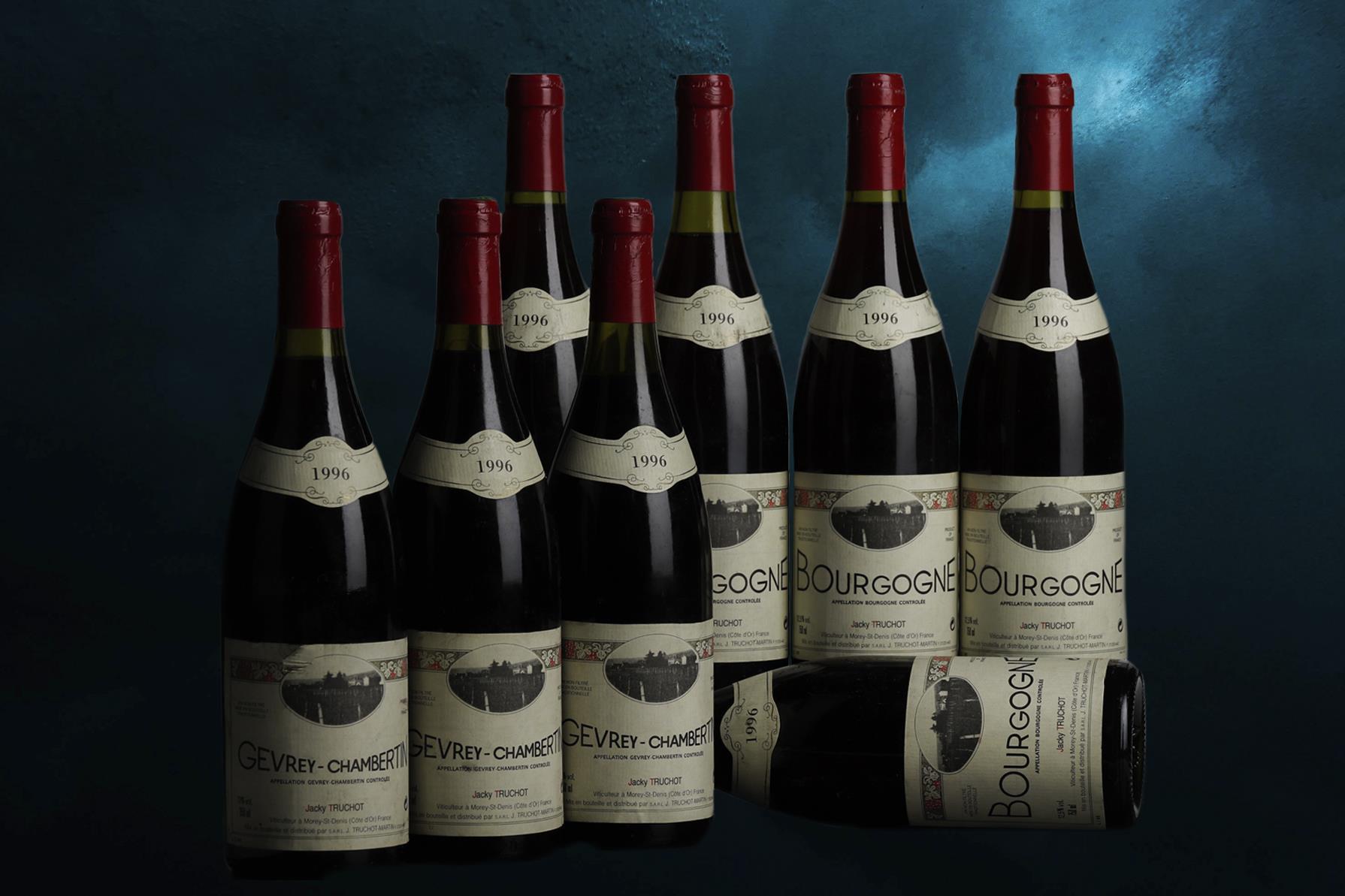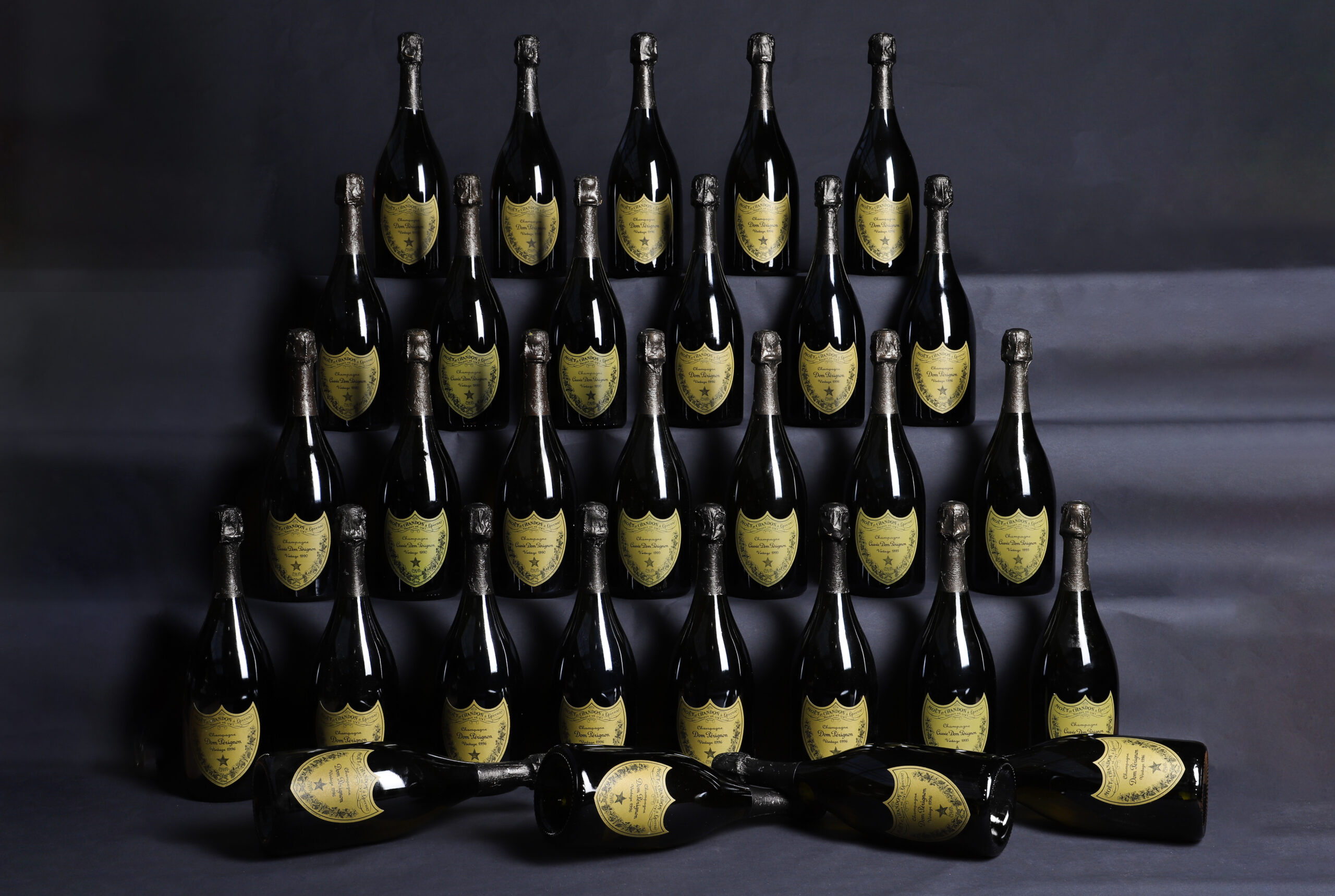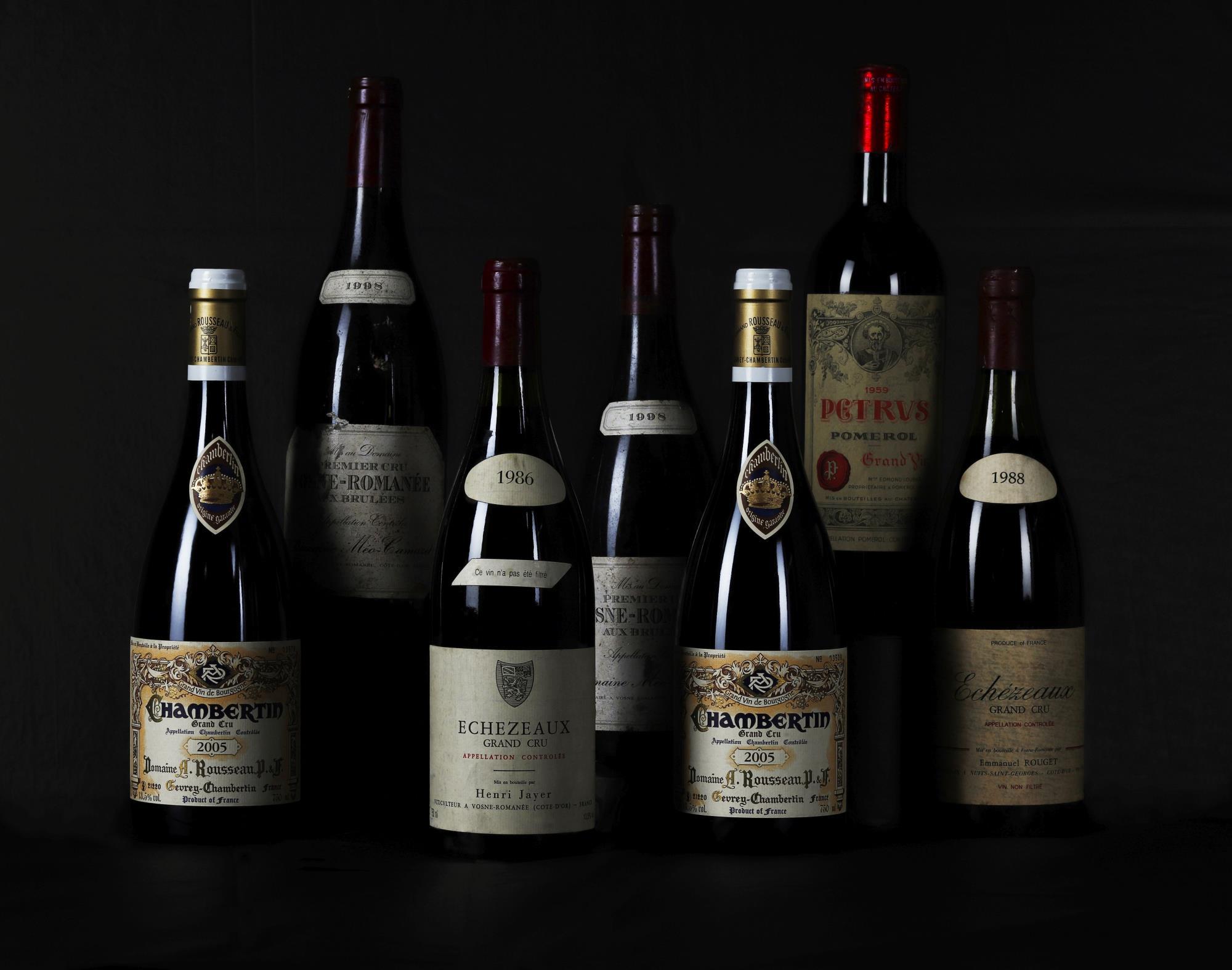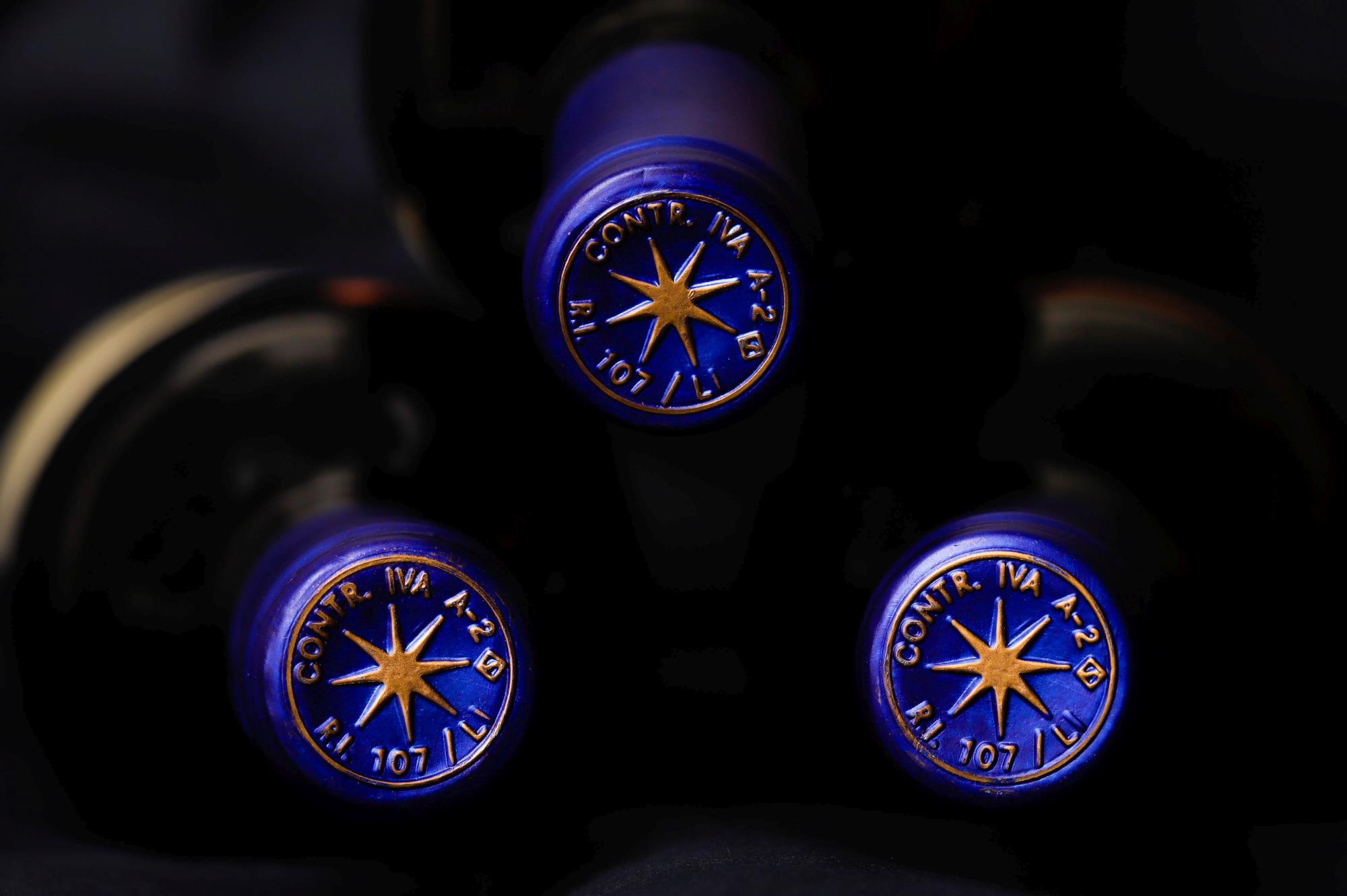Online wine auction platform for the most luxurious wines and champagnes
Wine Auction 27

Jacky Truchot , a respected vigneron in Burgundy, specifically in Gevrey-Chambertin.
He and his family were known for producing high-quality wines, especially red wines, from the Côte de Nuits area.
Jacky Truchot's wines were highly regarded for their craftsmanship and expression of the terroir.
This domaine produced several wines such as Gevrey Chambertin - Chambolle Musigny -Chambolle Musigny Les Sentiers
Morey Saint Denis - Morey Saint Denis Clos Sorbes - Morey Saint Denis Les Blanchards - Clos de la Roche - Charmes Chambertin.

Dom Pérignon is a prestigious brand of Champagne produced in the town of Épernay, in the Champagne region of France.
It's named after Dom Pierre Pérignon, a Benedictine monk who made significant contributions to the development
and refinement of Champagne production techniques in the 17th century.
Dom Pérignon Champagne is known for its high quality and is often associated with luxury and celebrations.
The brand is produced by Moët & Chandon, which is a prominent Champagne house.
Dom Pérignon Champagne is made exclusively from grapes grown in Grand Cru and Premier Cru vineyards, ensuring the finest quality grapes are used for production.
The brand is famous for its vintage Champagnes, meaning that the grapes used in a particular bottle come from a single year's harvest.
Dom Pérignon Champagnes are often characterized by their complexity, elegance, and aging potential.

Armand Rousseau
is a renowned Burgundy wine producer based in Gevrey-Chambertin, France. The domaine is highly respected for producing exceptional Pinot Noir wines from some of the finest vineyard sites in the Burgundy region.Armand Rousseau is known for its meticulous approach to winemaking and a commitment to showcasing the unique terroirs of Burgundy. The domaine owns and cultivates a range of vineyards, including grand crus and premier crus, which are some of the most sought-after plots in Burgundy.The wines from Armand Rousseau are often described as elegant, complex, and age-worthy. They are highly regarded among wine enthusiasts and collectors for their ability to age gracefully and express the nuances of the specific vineyard sites.
Henri Jayer
Jayer's approach to winemaking was characterized by meticulous attention to detail, a deep understanding of the land, and a commitment to traditional winemaking practices. He practiced low yields, hand-harvesting, and careful selection of grapes to ensure the highest quality. His work contributed to the elevation of Burgundy wines to the status of some of the finest and most sought-after wines in the worlddiv><.Some of his most famous wines include those from the Vosne-Romanée appellation, especially the Cros Parantoux vineyard. Jayer's wines, including his Richebourg and Cros Parantoux bottlings, are highly prized by collectors and enthusiasts. Due to his limited production and the exceptional quality of his wines, they often command high prices at auctions and in the secondary market.
Henri Jayer's legacy continues to influence winemakers around the world, and his wines remain benchmarks for what Burgundy can achieve. After his passing in 2006, his legacy lives on through the wines he created and the impact he had on the Burgundy wine industry.
Méo-Camuzet is a prominent and highly respected Burgundy wine producer based in the Vosne-Romanée region of Burgundy, France. The domaine is known for its exceptional Pinot Noir wines that showcase the terroir of some of the most prestigious vineyards in Burgundy. The estate was founded by Étienne Camuzet and was later managed by his granddaughter Jean-Nicolas Méo, who brought the family name into the winery's branding. Méo-Camuzet has gained a reputation for producing wines of great elegance, complexity, and aging potential. They own and manage vineyards in several renowned appellations, including Vosne-Romanée, Nuits-Saint-Georges, and Corton. Some of their most notable vineyards include Richebourg, Cros Parantoux, Clos de Vougeot, and Corton Clos Rognet. Similar to other top Burgundy producers, Méo-Camuzet follows traditional winemaking practices, emphasizing low yields, meticulous vineyard work, hand-harvesting, and a gentle approach in the cellar. The goal is to allow the characteristics of each specific vineyard site to shine through in the final wines. Méo-Camuzet's wines are highly sought after by collectors and enthusiasts and are considered some of the finest expressions of Burgundy terroir. They often receive high scores from wine critics and can command significant prices on the market due to their limited production and exceptional quality. Jean-Nicolas Méo has continued the legacy of his family's domaine and is dedicated to producing wines that reflect the unique characteristics of the Burgundy region. As of my last knowledge update in September 2021, Méo-Camuzet remains a respected and influential player in the Burgundy wine landscape. Please note that there may have been developments since tha style="text-align: center; "t time.
Petrus
is a renowned wine estate located in the Pomerol appellation of Bordeaux, France. It is widely regarded as one of the most prestigious and sought-after wineries in the world, producing exceptional red wines primarily from the Merlot grape variety. Here are some additional details about Petrus Pomerol: History and Ownership: Château Petrus has a history that dates back to the 18th century. The property was owned by the Arnaud family and was later acquired by the Moueix family in 1969. The Moueix family, notably Jean-Pierre Moueix and his son Christian Moueix, played a significant role in elevating the reputation of Petrus to its iconic status. Terroir and Vineyards: Petrus's vineyards cover around 11.4 hectares (28 acres) and are situated on a unique mix of clay and gravel soils with a high iron content. This terroir is believed to be a key factor contributing to the distinct character of Petrus wines. The vineyard's location on the right bank of the Gironde River in Pomerol allows for optimal ripening of the Merlot grapes. Grape Varieties: Merlot is the dominant grape variety at Petrus, typically accounting for about 95% of the blend. The remaining 5% consists of Cabernet Franc, which adds complexity and structure to the wines. Winemaking: The winemaking process at Château Petrus is characterized by traditional methods. Grapes are hand-harvested and sorted to ensure only the best fruit is used. Fermentation takes place in small vats, and the wine is aged in new oak barrels for about 18 to 24 months. The goal is to express the unique terroir while achieving elegance, depth, and aging potential. Aging Potential and Characteristics: Petrus wines are known for their remarkable aging potential. They often exhibit a deep, intense color and a complex bouquet of aromas, including dark fruits, truffle, earthy notes, and often a distinct iron-like minerality from the terroir. With time, the wines evolve, gaining depth, refinement, and a velvety texture. Collectibility and Market Value: Château Petrus's limited production, exceptional quality, and prestigious reputation have led to its wines being highly sought after by collectors, investors, and wine enthusiasts. Bottles of Petrus can command some of the highest prices in the wine market, making them a symbol of luxury and exclusivity. Château Petrus remains an iconic name in the world of wine, celebrated for its consistent excellence and unique expression of the Pomerol terroir.

Sassicaia is an iconic Italian wine produced in the Bolgheri region of Tuscany. It's considered one of Italy's most prestigious and internationally acclaimed wines. The name "Sassicaia" comes from the Italian word "sassi," meaning stones, which refers to the stony nature of the vineyards where the grapes are grown.
Sassicaia is often recognized as one of the original "Super Tuscan" wines. It was first produced by the Marquis Mario Incisa della Rocchetta in the mid-20th century, specifically in the 1940s. The Marquis was inspired by the Bordeaux-style wines of France and planted Cabernet Sauvignon vines on his estate in Bolgheri, which was unconventional for the region at that time.
The wine gained significant attention for its quality and unique character, and it played a significant role in changing the perception of Italian wines on the global stage. Sassicaia was eventually released commercially in the 1970s and quickly gained a reputation for its elegance, structure, and aging potential.



